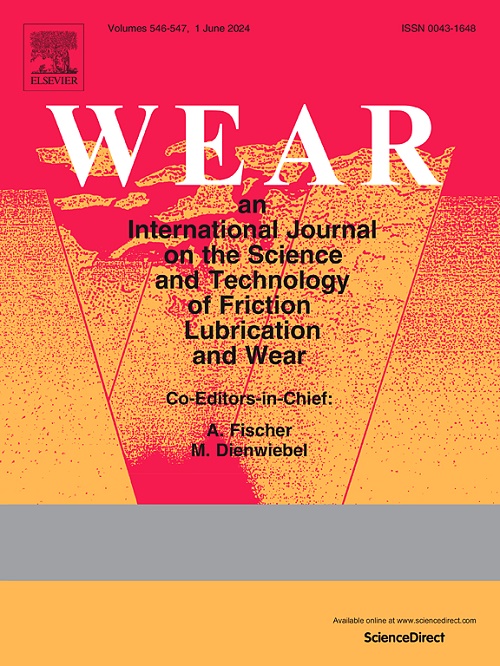Tribological properties of oscillatory pressure sintered SiC-based ceramics: Influence of load and sliding speed
IF 5.3
1区 工程技术
Q1 ENGINEERING, MECHANICAL
引用次数: 0
Abstract
The wear resistance of SiC-based ceramics is a crucial factor influencing their service life when they are used in the field of tribological engineering. Here, the influence of external factors (load and sliding speed) on the tribological properties of SiC-based ceramics prepared by oscillatory pressure sintering was explored together with an analysis of the wear mechanism of such ceramics. As the applied load increased from 20 N to 60 N, the surface roughness of specimens continuously increased. The corresponding wear mechanism underwent a change from plowing and plastic deformation to material fracture and abrasive wear. Furthermore, the wear rate of the specimen with 1 wt% graphene nanosheets (GNPs) and 5 wt% SiC whiskers (SiCw) increased from 3.15 ± 0.05 × 10−7 mm3·N−1·m−1 to 4.23 ± 0.09 × 10−7 mm3·N−1·m−1. As the sliding speed increased (2–6 m/min), the friction process generated a considerable amount of heat, resulting in an elevated surface temperature of the specimen; a more complete relief structure was formed on the wear surface, reducing the contact area of the specimen and thus enhancing the wear resistance of the specimen. The most favorable tribological performance of SiC-1 wt% GNPs-5 wt% SiCw ceramics in cyclic dry friction was attributed to the self-lubrication effect of GNPs and the enhancement of mechanical properties of SiC-based ceramics.
振荡压力烧结sic基陶瓷的摩擦学性能:载荷和滑动速度的影响
sic基陶瓷在摩擦学工程领域的应用,其耐磨性是影响其使用寿命的关键因素。本文探讨了载荷和滑动速度等外部因素对振荡压力烧结制备的sic基陶瓷摩擦学性能的影响,并分析了该陶瓷的磨损机理。随着外加荷载从20 N增加到60 N,试件表面粗糙度不断增大。相应的磨损机制经历了从犁耕和塑性变形到材料断裂和磨粒磨损的转变。此外,含有1 wt%石墨烯纳米片(GNPs)和5 wt% SiC晶须(SiCw)的试样的磨损率从3.15±0.05 × 10−7 mm3·N−1·m−1增加到4.23±0.09 × 10−7 mm3·N−1·m−1。随着滑动速度的增加(2 ~ 6 m/min),摩擦过程产生相当大的热量,导致试样表面温度升高;磨损面形成了更完整的浮雕结构,减小了试样的接触面积,从而提高了试样的耐磨性。SiC-1 wt% GNPs-5 wt% SiCw陶瓷在循环干摩擦中的良好摩擦学性能归因于GNPs的自润滑作用和sic基陶瓷力学性能的增强。
本文章由计算机程序翻译,如有差异,请以英文原文为准。
求助全文
约1分钟内获得全文
求助全文
来源期刊

Wear
工程技术-材料科学:综合
CiteScore
8.80
自引率
8.00%
发文量
280
审稿时长
47 days
期刊介绍:
Wear journal is dedicated to the advancement of basic and applied knowledge concerning the nature of wear of materials. Broadly, topics of interest range from development of fundamental understanding of the mechanisms of wear to innovative solutions to practical engineering problems. Authors of experimental studies are expected to comment on the repeatability of the data, and whenever possible, conduct multiple measurements under similar testing conditions. Further, Wear embraces the highest standards of professional ethics, and the detection of matching content, either in written or graphical form, from other publications by the current authors or by others, may result in rejection.
 求助内容:
求助内容: 应助结果提醒方式:
应助结果提醒方式:


